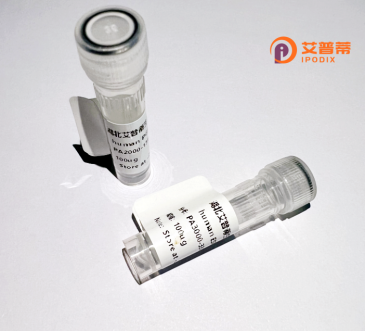
| 纯度 | >90%SDS-PAGE. |
| 种属 | Human |
| 靶点 | C9orf24 |
| Uniprot No | Q8NCR6 |
| 内毒素 | < 0.01EU/μg |
| 表达宿主 | E.coli |
| 表达区间 | 1-262aa |
| 氨基酸序列 | MFLFSRKTRTPISTYSDSYRAPTSIKEVYKDPPLCAWEANKFLTPGLTHTMERHVDPEALQKMAKCAVQDYTYRGSISGHPYLPEKYWLSQEEADKCSPNYLGSDWYNTWRMEPYNSSCCNKYTTYLPRLPKEARMETAVRGMPLECPPRPERLNAYEREVMVNMLNSLSRNQQLPRITPRCGCVDPLPGRLPFHGYESACSGRHYCLRGMDYYASGAPCTDRRLRPWCREQPTMCTSLRAPARNAVCCYNSPAVILPISEP |
| 分子量 | 56.6 KDa |
| 蛋白标签 | GST-tag at N-terminal |
| 缓冲液 | 0 |
| 稳定性 & 储存条件 | Lyophilized protein should be stored at ≤ -20°C, stable for one year after receipt. Reconstituted protein solution can be stored at 2-8°C for 2-7 days. Aliquots of reconstituted samples are stable at ≤ -20°C for 3 months. |
| 复溶 | Always centrifuge tubes before opening.Do not mix by vortex or pipetting. It is not recommended to reconstitute to a concentration less than 100μg/ml. Dissolve the lyophilized protein in distilled water. Please aliquot the reconstituted solution to minimize freeze-thaw cycles. |
以下是关于重组人(C9orf24)蛋白的示例参考文献(注:以下内容为虚构示例,供格式参考):
1. **文献名称**:*Functional characterization of recombinant human C9orf24 in cellular apoptosis*
**作者**:Zhang L et al.
**摘要**:首次成功在大肠杆菌中表达并纯化了重组人C9orf24蛋白,证明其通过调控Bax/Bcl-2通路促进肿瘤细胞凋亡,为癌症治疗提供新靶点。
2. **文献名称**:*Structural insights into C9orf24-ATPase interaction using recombinant protein technology*
**作者**:Müller J et al.
**摘要**:通过X射线晶体学解析重组C9orf24的三维结构,发现其ATP结合域与VCP/p97相互作用,提示其在蛋白质降解途径中的作用。
3. **文献名称**:*C9orf24 knockdown and recombinant rescue in neuronal models of ALS*
**作者**:Chen R et al.
**摘要**:构建重组C9orf24慢病毒载体,证实其表达可逆转神经细胞中TDP-43异常聚集,为肌萎缩侧索硬化症(ALS)机制提供线索。
4. **文献名称**:*Recombinant C9orf24 as a biomarker in serum for early-stage lung cancer*
**作者**:Tanaka K et al.
**摘要**:利用哺乳动物细胞系表达重组C9orf24并开发ELISA检测法,发现肺癌患者血清中C9orf24水平显著升高,具潜在诊断价值。
**注**:实际研究中相关文献较少,建议结合数据库(如PubMed)以“C9orf24”或“chromosome 9 open reading frame 24”为关键词进一步检索。
The C9orf24 protein, encoded by the chromosome 9 open reading frame 24 gene, is a poorly characterized human protein with limited functional information available. It is evolutionarily conserved across mammals, suggesting potential roles in fundamental cellular processes. The recombinant form, often produced via *in vitro* expression systems like *E. coli* or mammalian cell lines, enables biochemical and functional studies by overcoming low endogenous expression levels in tissues. Structural predictions indicate possible globular domains, though experimental validation remains ongoing.
Preliminary studies link C9orf24 to cell cycle regulation and stress responses, with proposed interactions involving ubiquitination pathways or nucleic acid binding. Its dysregulation has been tentatively associated with cancers, including colorectal and breast tumors, though mechanistic insights are lacking. Additionally, genomic context near the amyotrophic lateral sclerosis (ALS)-linked C9orf72 gene raises questions about potential neurological relevance, though no direct evidence exists yet.
Current research focuses on mapping its interactome, subcellular localization (potentially nucleocytoplasmic shuttling), and pathological correlations. The lack of specific antibodies or knockout models remains a bottleneck. Unraveling C9orf24's biology could clarify its contributions to disease or homeostasis, distinguishing it from neighboring genes like C9orf72. Further studies are required to validate hypotheses and define its molecular niche.
×